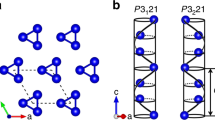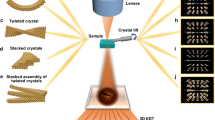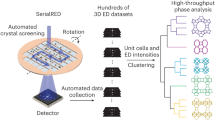Abstract
Chiral crystals can be exploited for applications in enantioselective separation and catalysis. However, the study of chirality at the atomic level in a sub-micrometre-sized crystal is difficult due to the lack of adequate characterization methods. Herein, we present two efficient and practical methods of characterization that are based on electron crystallography. These methods are successfully applied to reveal the handedness of a chiral, zeolite nanocrystal. The handedness is identified through either a comparison of two high-resolution transmission electron microscope images, taken from the same nanocrystal but along different zone axes by tilting it around its screw axis, or the intensity asymmetry of a Bijvoet pair of reflections in a single precession electron-diffraction pattern. These two approaches provide new ways to determine the handedness of small, chiral crystals.
This is a preview of subscription content, access via your institution
Access options
Access Nature and 54 other Nature Portfolio journals
Get Nature+, our best-value online-access subscription
$29.99 / 30 days
cancel any time
Subscribe to this journal
Receive 12 print issues and online access
$259.00 per year
only $21.58 per issue
Buy this article
- Purchase on Springer Link
- Instant access to full article PDF
Prices may be subject to local taxes which are calculated during checkout




Similar content being viewed by others
Change history
02 June 2017
In the Fig. 2 caption, the following text has been added: "We chose the c axis upwards for convenience." In the first paragraph of 'Determination of handedness by HRTEM imaging', the following text has been added: "For either left or right handedness, the shift direction depends only on the crystal rotation. When a right-handed crystal is rotated anticlockwise with the rotation axis up, the image shift from f1 to f2 is always downwards, irrespective of the c-axis direction. The choice does not affect the determination of the handedness."
References
Yang, Y., Su, B., Yan, Q. & Ren, Q. Separation of naproxen enantiomers by supercritical/subcritical fluid chromatography. J. Pharm. Biomed. Anal. 39, 815–818 (2005).
Pasteur, L. Recherches sur les relations qui peuvent exister entre la forme crystalline, la composition chimique et le sens de la polarization rotatoire. Ann. Chim. Phys. 24, 442–459 (1848).
Bijvoet, J. M., Peerdeman, A. F. & Bommel, A. J. Determination of the absolute configuration of optically active compounds by means of X-rays. Nature 168, 271–272 (1951).
Hamilton, W. C. Significance tests on the crystallographic R factor. Acta Cryst. 18, 502–510 (1965).
Rogers, D. On the application of Hamiton’s ratio test to the assignment of absolute configuration and an alternative test. Acta Cryst. A 37, 734–741 (1981).
Flack, H. D. On enantiomorph-polarity estimation. Acta Cryst. A 39, 876–881 (1983).
Escudero-Adan, E. C., Benet-Buchholz, J. & Ballester, P. The use of Mo Kα radiation in the assignment of the absolute configuration of light-atom molecules; the importance of high-resolution data. Acta Cryst. B 80, 660–668 (2014).
Scott, M. C. et al. Electron tomography at 2.4-ångström resolution. Nature 483, 444–447 (2012).
Goodman, P. & Secomb, T. W. Identification of enantiomorphously related space groups by electron diffraction. Acta Cryst. A 33, 126–133 (1977).
Goodman, P. & Johnson, A. W. S. Identification of enantiomorphically-related space groups by electron diffraction—a second method. Acta Cryst. A 33, 997–1001 (1977).
Tanaka, M., Takayoshi, H., Ishida, M. & Endoh, Y. Crystal chirality and helicity of the helical spin density wave in MnSi. I. convergent-beam electron diffraction. J. Phys. Soc. Japan 54, 2970–2974 (1985).
Spence, J. C. H., Zuo, J. M., O’Keeffe, M., Marthinsen, K. & Hoier, R. On the minimum number of beams needed to distinguish enantiomorphs in X-ray and electron diffraction. Acta Cryst. A 50, 647–650 (1994).
Saitoh, K., Tsuda, K., Terauchi, M. & Tanaka, M. Distinction between space groups having principle rotation and screw axes, which are combined with twofold rotation axes, using the coherent convergent-beam electron diffraction method. Acta Cryst. A 57, 219–230 (2001).
Inui, H., Fujii, A., Tanaka, K., Sakamoto, H. & Ishizuka, K. New electron diffraction method to identify the chirality of enantiomorphic crystals. Acta Cryst. B 59, 802–810 (2003).
Morikawa, D., Shibata, K., Kanazawa, N., Yu, X. Z. & Tokura, Y. Crystal chirality and skyrmion helicity in MnSi and (Fe, Co)Si as determined by transmission electron microscopy. Phys. Rev. B 88, 0244081–0240814 (2013).
Tokunaga, Y. et al. A new class of chiral materials hosting magnetic skyrmions beyond room temperature. Nat. Commun. 6, 7638–7644 (2015).
Cowley, J. M., Nikolaev, P., Thess, A. & Smalley, R. E. Electron nano-diffraction study of carbon single-walled nanotube ropes. Chem. Phys. Lett. 265, 379–384 (1997).
Qin, L. C., Ichihashi, T. & Iijima, S. On the measurement of helicity of carbon nanotubes. Ultramicroscopy 67, 181–189 (1997).
Bernaerts, D., Amelinckx, S., Van Tendeloo, G. & Van Landuyt, J. Electron microscopy of carbon nanotubes and related structures. J. Phys. Chem. Solids 58, 1807–1813 (1997).
Che, S. et al. Synthesis and characterization of chiral mesoporous silica. Nature 429, 281–284 (2004).
Ohsuna, T., Liu, Z., Che, S. & Terasaki, O. Characterization of chiral mesoporous materials by transmission electron microscopy. Small 1, 233–237 (2005).
Juchtmans, R., Béché, A., Abakumov, A., Batuk, M. & Verbeeck Using electron vortex beams to determine chirality of crystals in transmission electron microscopy. J. Phys. Rev. B 91, 094112 (2015).
Winkelmann, A. & Nolze, G. Chirality determination of quartz crystals using electron backscatter diffraction. Ultramicroscopy 149, 58–63 (2015).
Vincent, R. & Midgley, P. Double conical beam-rocking system for measurement of integrated electron diffraction intensities. Ultramicroscopy 53, 271–282 (1994).
Wan, K. T. & Davis, M. E. Design and synthesis of a heterogeneous asymmetric catalyst. Nature 370, 449–450 (1994).
Davis, M. E. New vistas in zeolite and molecular sieve catalysis. Acc. Chem. Res. 26, 111–115 (1993).
Yu, J. H. & Xu, R. R. Chiral zeolite materials: structure insight and synthetic challenges. J. Mater. Chem. 18, 4021–4030 (2008).
Terasaki, O. in Molecular Sieves-Science and Technology Vol. 2 (eds Karge, H. G. & Weitkamp, J.) 72–110 (Springer, 1999).
Terasaki, O. Fine structures of zeolites. J. Electron Microsc. 43, 337–346 (1994).
Zeolite Framework Types (IZA-SC, 2017); http://asia.iza-structure.org/IZA-SC/ftc_table.php
Rojas, A., Arteaga, O., Kahr, B. & Camblor, M. A. Synthesis, structure, and optical activity of HPM-1, a pure silica chiral zeolite. J. Am. Chem. Soc. 135, 11975–11984 (2013).
Schmidt, J. E., Deem, M. W. & Davis, M. E. Synthesis of a specified, silica molecular sieve by using computationally predicted organic structure-directing agents. Angew. Chem. Int. Ed. 53, 8372–8374 (2014).
Gemmi, M. & Oleynikov, P. Scanning reciprocal space for solving unknown structures: energy filtered diffraction tomography and rotation diffraction tomography methods. Z. Kristallogr. 228, 51–58 (2013).
Allen, L. J., McBride, W., O’Leary, N. L. & Oxley, M. P. Exit wave reconstruction at atomic resolution. Ultramicroscopy 100, 91–104 (2004).
Wan, W., Hovmöller, S. & Zou, X. Structure projection reconstruction from through-focus series of high-resolution transmission electron microscopy images. Ultramicroscopy 115, 50–60 (2012).
Oleynikov, P. eMap and eSlice: a software package for crystallographic computing. Cryst. Res. Technol. 46, 569–579 (2011).
Acknowledgements
The authors acknowledge M. A. Camblor (ICMM, Madrid, Spain) and M. E. Davis (CALTECH, USA) for providing them with the zeolite samples. The authors also thank K. Tsuda (Tohoku University, Japan) for CBED experiments and discussions, W. Wan (Stockholm University, Sweden) for help with the through-focus series of HRTEM images, I. Onishi for help on TEM experiments, S. Asahina for help on SEM experiments and T. Ohsuna (Nagoya University, Japan) for discussions. Support from VR (Y.M. & P.O.), JEOL Ltd (P.O.), Berzelii Centre EXSELENT on Porous Materials and 3DEM-Natur, Sweden, BK21 Plus, Korea (O.T.) and the Shanghaitech Startup Funding (Y.M.) is acknowledged.
Author information
Authors and Affiliations
Contributions
O.T. and P.O. designed and guided the project. Y.M. and P.O. performed PED experiments and Y.M. performed HRTEM experiments. Y.M., O.T. and P. O. contributed to the manuscript.
Corresponding authors
Ethics declarations
Competing interests
The authors declare no competing financial interests.
Supplementary information
Supplementary Information
Supplementary Information (PDF 2313 kb)
Rights and permissions
About this article
Cite this article
Ma, Y., Oleynikov, P. & Terasaki, O. Electron crystallography for determining the handedness of a chiral zeolite nanocrystal. Nature Mater 16, 755–759 (2017). https://doi.org/10.1038/nmat4890
Received:
Accepted:
Published:
Issue Date:
DOI: https://doi.org/10.1038/nmat4890
This article is cited by
-
Accurate structure models and absolute configuration determination using dynamical effects in continuous-rotation 3D electron diffraction data
Nature Chemistry (2023)
-
Synchronous quantitative analysis of chiral mesostructured inorganic crystals by 3D electron diffraction tomography
Nature Communications (2022)
-
Establishing electron diffraction in chemical crystallography
Nature Reviews Chemistry (2021)
-
Emerging applications of zeolites in catalysis, separation and host–guest assembly
Nature Reviews Materials (2021)
-
Atomic-level handedness determination of chiral crystals using aberration-corrected scanning transmission electron microscopy
Nature Communications (2020)



